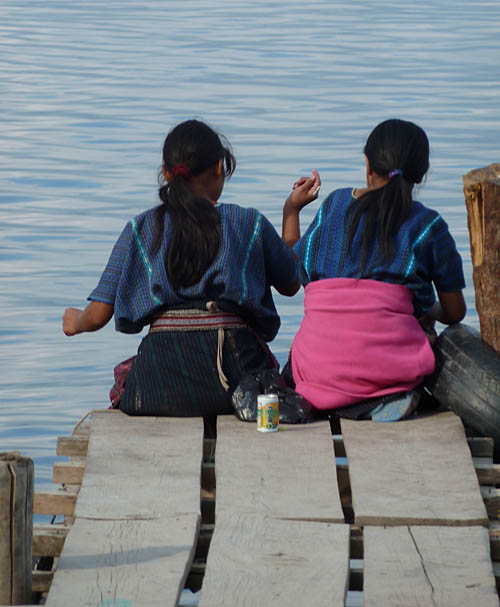Today was another typical day here in San Antonio Palopo, so typical, that it is worth telling you about. This morning I walked up to the markets to buy my usual pan frances (unsweetened rolls) at the small tienda owned by Julio and Rosa, plus a few plump tomatoes, an avocado, and a couple of small onions from the various ladies who regularly spend their days in the markets. Lunch! I splurged today and added a can of apple juice.
I then walked down the hill (north) to take a closer look at the area that was devastated by the mud and rock slides in September. One can only try to imagine what the terror of that tragic night must have been. On the way I was stopped by a couple of the women who I know from the cooking and sewing classes at the Centro Qawinak, just to say Hi. Oh, well, one did want to sell me chalinas (scarves), but she didn’t push it.
I made a decision to go down past the man who sits most days on the steps that lead down to the lakefront from the church, not my usual route. I had an inexplicable urge to talk to him. He told me his name was Santos Sicay, and that he had been blind for about twenty years. His sign read (in English):
Please help me out to survive. I’m a blind person and can’t no longer make a living on my own. Thank you very much and God bless you on your way. He said he went blind
poco a poco and that he could now no longer see anything. He explained how he lived close by, and how it was difficult for him to traverse the complex, maze-like paths that link the dwellings in San Antonio Palopo, so he rarely ventured from this area. We chatted for about ten minutes about this and that. I asked him how old he was.
Sixty-five, was his answer.
Oh, I said,
I’m almost sixty-five too. He found this strangely amusing and laughed his head off. Maybe it was my Spanish! Anyway, I pressed a few coins into his hand and left thinking: well, if all I have done today is to give a blind man a good laugh, it’s been a day well spent.
Later, after lunch, I went to the
Centro Qawinak to see if Felipa (our project Director) needed any help with her Spanish class. As usual, the little boys and one tiny little girl (Karina) were causing havoc, seemingly unnoticed by their mothers, nor by Felipa. The women were there to learn Spanish. They are some of the many unfortunate ones who missed school, because they had to work for their parents, or because their parents could not afford the school fees Guatemalans must pay. The Centre is helping them catch up, and they are taking precious time out of their days to take advantage of what the program offers. I took the kids outside to the adjoining room and brought a bundle of crayons and sheets of paper with me; there was much laughter, but each of them eagerly sat quietly on a step and drew some wonderful pictures.
These kids are typical of the indigenous kids throughout Guatemala. Only today in the
Guatemala Times there was article about the possibility of the Guatemalan government enacting a national food emergency in Guatemala. It stated:
About 49 percent of children in Guatemala are chronically malnourished according to the World Food Program—the fourth highest rate in the world. In indigenous communities the rate is closer to 70 percent. 
Little Karina (left) fits the picture to a tee. She is way too small for her age, has an almost blank stare about her, and is an obvious victim of poverty and deficient nutrition. All of these kids today had runny noses and needed a good bath. None had shoes. One can only wonder at their futures.
In the evening, I taught my English class to about 20 keeners. It’s such a delight to see the eagerness in these people – half of them adults, half of them kids of about 10 to 12 years old. The questions, the willingness to learn, it’s simply a wonderful experience. Tonight I decided to divert from the boring verbs we have been concentrating on lately (although they assured me that verbs are not boring) to do a class on food. I learned a few new words – for example, what I call a chayote (or choko in Australia) they call a guisquil (but with two dots over the “u” and sounding like whiskil). There was loads of laughter as they listened to me trying to pronounce it. To get back at them, I gave them the dreaded Homework! They have to write out a recipe using the new words they learned tonight – in English! Little Luis came to me after the class and asked if it would be all right if he just did the words in English, and did the description of how you make the recipe, in Spanish. He and his brother, Alex, are two of my favourites. At the end of each class, they have the loudest voices when we all say: Are you ready? Yes! OK, let’s Go!, always causing the adults in the class to burst out laughing. And, as usual, before she slips out the door, lovely Reina hands me a note that always gives me such a warm feeling. Tonight’s note says: Tricia, te mando esta carta para ti, Tricia gracias porque estoy aprendiendo un poco Englesh. Reina, Buena amiga which translates, more or less: Tricia, I send this letter to you, Tricia, to thank you because I'm learning a little Englesh. Reina, your good friend.
And so another day goes by in this enchanting little town.
















